Balmoral Software
Balmoral Software
converges; that is, |zn| is finite as
zn+1 = z2n + c, z0 = c (1)
The largest areas of M are a cardioid having its left edge at -3/4 and its cusp at 1/4, and a circle of radius 1/4 centered at (-1,0). Other regions of M include smaller near-circular "buds" [2] tangent to the main cardioid or to each other, as well as fractal filaments extending into other areas of the complex plane.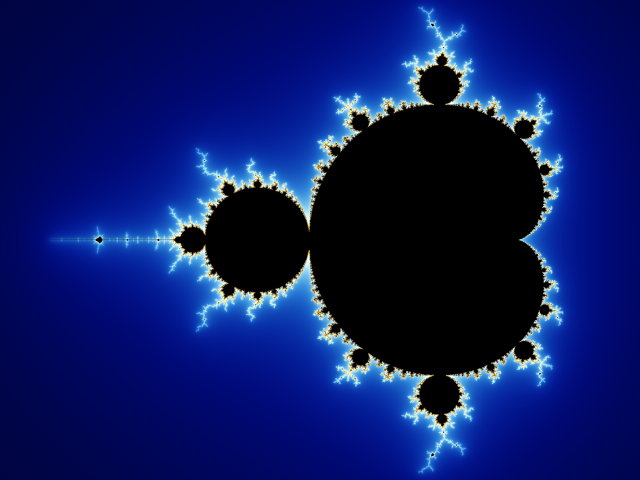
The orbit of a starting point that is within the Mandelbrot set does not itself need to consist of points inside the set; for example, the orbit of
immediately cycles amongst the three values
c = -0.1225611668766536 - 0.7448617666197442i, (2)
so c is in the Mandelbrot set but z1 is not since starting the orbit at z1 results in divergence in (1) after about six iterations. This period-3 cycle is shown as a brown triangle in the diagram below.
z0 = -0.1225611668766536 - 0.7448617666197442i
z1 = -0.6623589786223729 - 0.5622795120623012i
z2 = 0,(3)
The value of c above was found by equating it to the result of three iterations of (1):
z0 = cIgnoring the trivial solution c = 0, we havez1 = z20 + c = c2 + c
z2 = z21 + c = (c2 + c)2 + c = c4 + 2c3 + c2 + c
z3 = z22 + c = z0 = c
z2 = 0
c3 + 2c2 + c + 1 = 0,which has complicated closed-form solutions approximated by
c = -1.7548776662466928 + 0i,(2), and its conjugate. The repeating cycle corresponding to the first point remains on the real axis:
z0 = -1.7548776662466928and the cycle corresponding to the second point is given in (3) above.
z1 = 1.3247179572447461
z2 = 0
The diagram below is an approximation to the boundary of M [5], in which orbits of other sample points in the Mandelbrot set are shown in color with starting squares representing c:
In clockwise order starting near the top of the cardioid, these orbits are: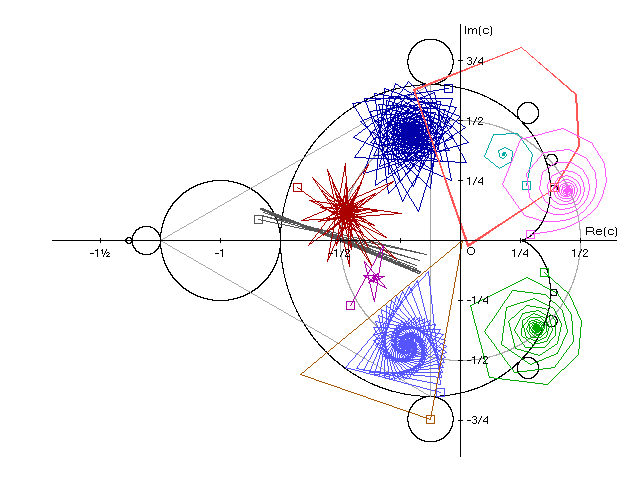
| Color | c | Orbit |
|---|---|---|
| Dark blue | -0.05 + 0.6333i | Converges in a weblike pattern to the stationary point -0.2074 + 0.4476i |
| Cyan | 0.2767 + 0.23i | Quickly converges in a small spiral to the stationary point 0.18 + 0.3593i |
| Orange | 0.39 + 0.22i | Starting at the center of one of the main cardioid's east bulbs, cycles between 6 values inside and outside M |
| Pink | 0.29 + 0.0233i | Smooth spiral converging on the stationary point 0.4439 + 0.2077i, which is outside the main cardioid of M |
| Green | 0.35 - 0.1333i | From a point near the boundary of the main cardioid, spirals in to the stationary point 0.3175 + 0.3651i |
| Brown | -0.1267 - 0.7467i | Starting at the center of the south bulb, oscillates between 3 values, one in the bulb, the other near the origin, and the third outside M |
| Medium blue | -0.0833 - 0.6333i | Again starting near the main cardioid boundary, spirals in to the stationary point -0.2242 - 0.4372i |
| Purple | -0.46 - 0.27i | Converges in a small starlike pattern to the stationary point -0.3572 - 0.1575i |
| Dark gray | -0.8433 + 0.0867i | Starting in the largest bulb at left, oscillates between two values in M |
| Red | -0.68 + 0.22i | From the left side of the main cardioid, converges in a large starburst pattern to the stationary point -0.4710 + 0.1133i |
and
z = z2 + c (11)
A value z satisfying (4) lies within a circle S of radius 1/2 centered at the origin, shown in light gray on the diagram above. The first expression above is a quadratic with solution
|z| ≤ 1/2 (4)
Let the principal square root

(5)
 be denoted by
be denoted by
so (4) is not satisfied. As a result, we can ignore the positive root in (5) and the stationary point z associated with c is
Closed-form solution for the stationary point
If we let
we can solve for a and b algebraically: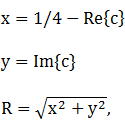
For example, let c = -0.68 + 0.22i (red orbit in figure above):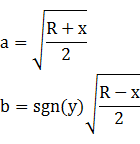
Boundary mapping
It's easy to see that if c is on the boundary of the main cardioid, its stationary point z occurs on S.
Proof. A point c on the boundary of the main cardioid of M is defined by
Re{c} = [1 - cos(t)]cos(t)/2 + 1/4which reduces toIm{c} = [1 - cos(t)]sin(t)/2,
c = eit/2 - e2it/4Substituting for the negative root in (5), we have
so |z| = 1/2, QED.
Cardioid location test
A point z = a + bi is on or inside the main cardioid of M if and only if
Proof. It's simpler to compare z with the cardioid boundary after translation. With respect to the origin of M, translate the main cardioid to the left by 1/4 so that it can be represented by the polar function

(6)
r(t) = [1 - cos(t)]/2, 0 ≤ t < 2πSimilarly, translate the given point z to the left by 1/4, denoting the transformed value by w:
w = (a - 1/4) + biThe distance of w from the origin is
Measured counterclockwise from the positive real axis, the radial angle associated with w is
θ = Atan2(b,a - 1/4)The distance of the translated cardioid from the origin along a line to w is
It follows that the original point z is on or inside the Mandelbrot main cardioid if and only if
dw ≤ dCwhich simplifies to2dw ≤ 1 - (a - 1/4)/dw,
(4dw - 1)2 ≤ 3 - 8a, QED.This formula is equivalent to those in Wikipedia.
Mandelbrot set regions
There can be orbits that converge on points outside the main cardioid of M, as shown in light blue in the diagram below. Likewise, stationary points cannot occur within the green areas of the main cardioid since they are outside S:
For example, applying (6) to the starting point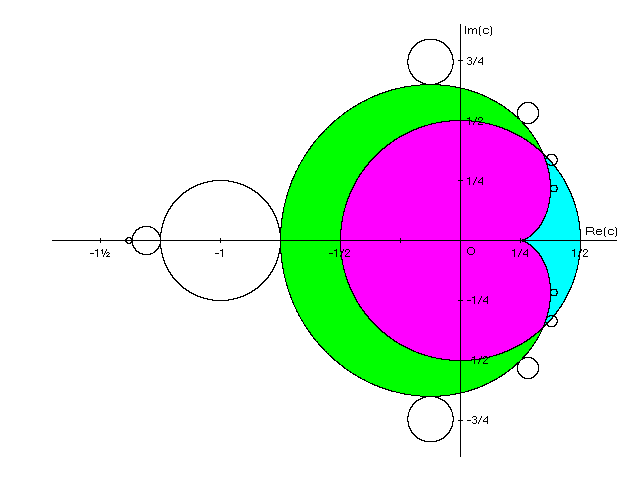
Therefore, c is just inside the main cardioid, and also inside S since
so z is outside the main cardioid. The orbit from c to z is shown in pink in the preceding diagram.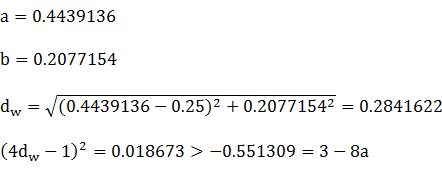
 and its
maximum ordinate at
and its
maximum ordinate at 
To determine the intersection of the main cardioid and S, in the
implicit formula for
the cardioid, substitute 1/2 for a and
[(x - 1/4)2 + y2 + (x - 1/4)/2]2 = [(x - 1/4)2 + y2]/4and
x2 + y2 = 1/4The solutions are

In terms of area, most of the Mandelbrot set consists of its main cardioid together with its buds. In fact, the main cardioid plus its largest bud centered at -1 on the real axis together account for roughly 80-90% of the area of M (the exact area of M is unknown but bounded) [6].
The leftmost point P of the largest bud and the top and bottom points Q and R of the main cardioid form an equilateral triangle, as shown in light gray in the diagram above:
Asymmetric or "deformed" Mandelbrot cardioids can occur in minibrots deep within the boundary of M [7]. For example, consider a point c in the Seahorse Valley separating the main cardioid and largest bud of M: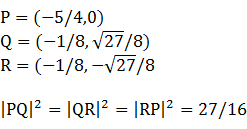
c = -0.74583256875 + 0.1100764125iApply a magnification of 4000 and rotate the image counterclockwise by 105° to obtain the following image:
[2] Vepstas, L., "Mandelbrot Bud Maths", 2000.
[3] Cross, D., "Algebraic solution of Mandelbrot orbital boundaries", 2005.
[4] Devaney, R., "The Fractal Geometry of the Mandelbrot Set".
[5] Majewski, A., Wikibooks "Mandelbrot set components", 2008.
[6] Bittner, D., et. al., "New Approximations for the Area of the Mandelbrot Set", Involve: A Journal of Mathematics, 10(4) 555-572, 2017.
[7] Davis, A., et. al., "Warped Midgets in the Mandelbrot Set", Computers & Graphics, Vol. 18, Issue 2, 1994, reprinted in Pickover, C. (ed.), Chaos and Fractals: A Computer Graphical Journey, 1998: Elsevier Science B.V.
Copyright © 2022 Balmoral Software (http://www.balmoralsoftware.com). All rights reserved.